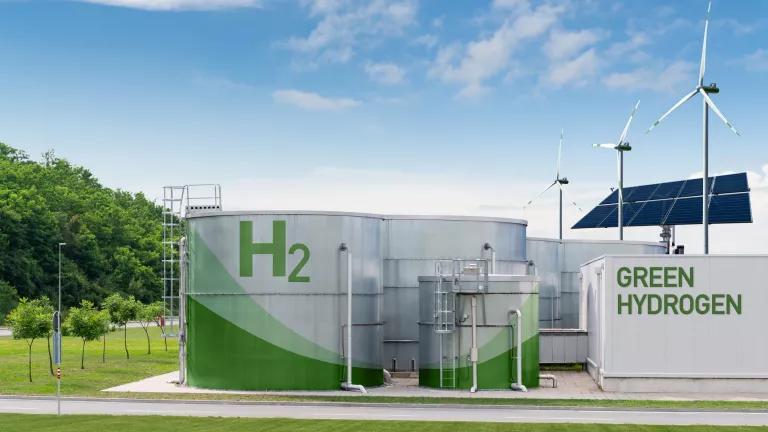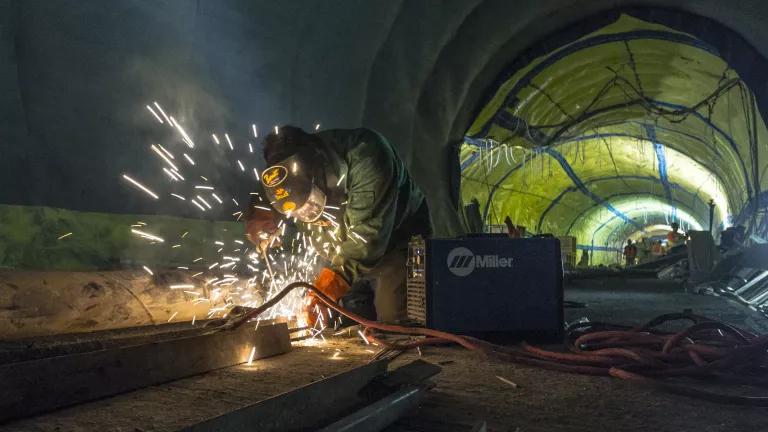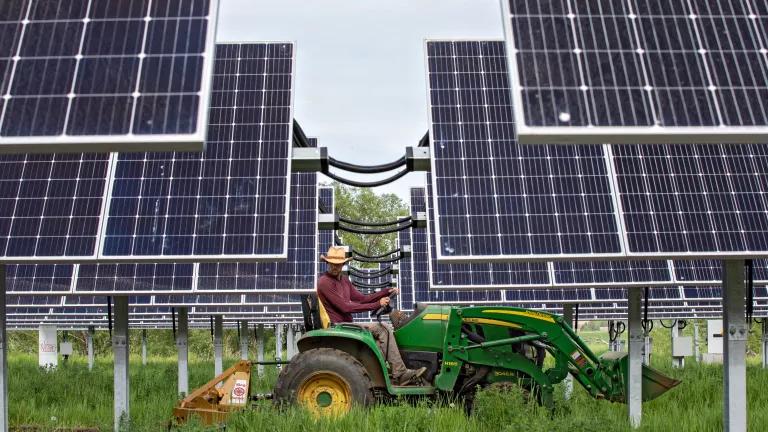Hubs Rollout Underscores Need for Climate-aligned Policies
For the sake of the climate and communities, DOE and the selected hubs must redouble their focus on truly clean production and high value end-uses.

Last week we got our first glimpse of the U.S. Department of Energy’s flagship hydrogen hubs (H2Hubs) program that will set the tone for the nascent U.S. clean hydrogen market. At a high-profile event in Philadelphia, President Biden revealed that seven hubs have been selected to begin negotiations for their anticipated share of $7 billion in funding appropriated in the Bipartisan Infrastructure Law (BIL).
U.S. hydrogen ambitions should be predicated on the opportunity to use it to decarbonize key sectors where direct electrification may not be feasible. We have a chance to create a clean hydrogen economy with truly clean production and well-tailored applications, but doing so will require rigor, community input, and well-designed policies.
In that regard, the seven selected H2Hubs are a mixed bag. We are pleased to see some of the funding go to green electrolytic production and hydrogen deployment in hard-to-electrify end-uses like steel and aviation; as we have extensively written, those are likely to be hydrogen’s best end-uses. But the over-reliance on fossil fuel-derived hydrogen, and hydrogen produced by diverting existing clean energy away from homes and businesses, as well as the possibility of wasting valuable hydrogen in low value applications, give us pause.
The proof will be in the pudding. The H2Hubs will turbocharge hydrogen’s role in the U.S. energy sector, but we still don’t have widespread policy and investment guardrails in place to ensure that it supports the transition to a clean economy or to prevent an emissions mess. It is now more imperative than ever for the administration and the states that will house the H2Hubs to implement rigorous rules ensuring that hydrogen produced in the H2Hubs—and in the U.S. more broadly—is squeaky clean and that it is targeted in the most valuable applications that may not have other viable clean energy solutions. If those guardrails are not implemented in lockstep with the H2Hubs progress, the entire climate benefits of the H2hubs will be compromised.
A summary of H2Hubs selected:

Summary table of H2hub selectee information released by the Department of Energy.
*Relative volumes of production from different pathways have not been released, this table is indicative of the pathways included and not their relative production amounts or investments.
Over-reliance on fossil fuel-derived hydrogen and existing clean energy resources emphasize the need for robust hydrogen production rules.
As we explain in a previous blog, electrolytic hydrogen powered by renewable energy (also known as “green” hydrogen) is a superior climate solution to fossil-derived hydrogen, as the latter carries the climate and public health risks inherent to fossil fuels. The H2Hubs’ heavy emphasis on projects that inherently carry more climate and health risks puts us on a steeper path to align hydrogen with U.S. climate goals.
But even electrolytic hydrogen carries climate risks if not governed by strict rules. This is playing out in the heated debate in the context of the Inflation Reduction Act’s (IRA) 45V clean hydrogen tax credits. Electrolytic hydrogen production is very power-hungry. Electrolyzers require large amounts of energy to run, and without airtight tax credit guidelines hydrogen producers will be rewarded for diverting existing clean energy that is already powering our homes and businesses while driving increased fossil fueled electricity to address the gap. This would create an emissions mess and compromise the decarbonization of the U.S. electricity grid. It also risks increasing electricity prices for U.S. homes, businesses, and industrials.
DOE estimates that the H2Hubs will eventually deliver 25 million metric tons of annual emissions reductions—the equivalent of taking 5.5 million gasoline-powered cars off the road. Notably, this estimate only accounts for emissions avoided by replacing fossil fuels with hydrogen in the various selected applications—e.g., replacing diesel fuel with hydrogen in trucks. DOE does not account for the emissions linked to hydrogen production. Without guardrails, hydrogen production can be very carbon intensive and, as we have previously written, can entirely offset any emissions reductions from hydrogen displacing fossil fuels on the end-use side.
If hydrogen production in the H2Hubs is dirty and carbon-intensive, the H2Hubs could end up increasing U.S. carbon emissions.
Hydrogen production rules are being defined in the context of the IRA 45V tax credits, which we have extensively written about. It is therefore more imperative than ever for the administration to get the 45V rules right, to ensure that hydrogen production in the H2Hubs—and U.S. more broadly—is truly “clean” and that the H2Hubs actually deliver on their intent to turbocharge a clean hydrogen industry and climate progress. In forthcoming Treasury guidelines, the administration should require:
- For fossil-derived hydrogen: accurate accounting of upstream methane leakage based on in-field measurements, as opposed to highly inaccurate on-paper estimates that significantly underestimate the true extent of methane leaks. Outside of the 45V context, DOE should also only support best-in-class projects that capture at least 90% of their carbon and demonstrate its safe and permanent underground storage.
- For electrolytic hydrogen: compliance with the three pillars widely backed by environmental groups and industry groups of 1) new clean supply (aka, additionality), 2) deliverability, and 3) hourly matching.

The focus on hard-to-electrify applications is encouraging. DOE must ensure that hydrogen is not wasted in applications with better clean energy alternatives.
The hydrogen hubs’ potential is greatest in demonstrating and de-risking the use of clean hydrogen in hard-to-electrify applications. In particular, we are excited to see the inclusion of hard-to-electrify sectors like steel, fertilizer production, aviation, and shipping amongst the selected proposals.
That said, we do not yet have clarity on the relative volumes of hydrogen to be used in the different end- uses. It is critical that DOE hold firm and ensure that actual projects retain a focus on hard-to-electrify applications and that hydrogen is not wasted in applications that better and cheaper alternatives—including cars, power plants and buildings. For example, the power sector figures repeatedly in the listed H2Hub applications; but this use of hydrogen should be limited due to the chain of energy conversions necessary to produce the hydrogen first and convert it back to electricity.
Transparency and information sharing have hitherto been paltry; DOE should urgently and significantly increase both.
As we raised in a letter to DOE earlier this year—signed by a wide range of peer environmental NGOs and community groups—transparency is critical to the durable success of the H2hubs. But transparency has been sorely lacking to date, which has resulted in community groups on the frontlines of the H2hubs projects and civil society more broadly being in the dark on virtually all details of then-candidate H2hubs. This has stoked acute mistrust in the H2Hubs program and its benefits (for example, a letter spearheaded by the Center for Biological Diversity urged DOE to withhold funding for all H2hubs). Course correction is therefore urgently needed.
The high-level information provided today by DOE is welcome and marks a degree of improvement in information sharing, but there is scope for substantially more to be shared, especially as projects in the H2Hubs progress. It is critical that moving forward, DOE actively and consistently share a range of details, including about locations of proposed projects, local pollution impacts, and relative volumes of hydrogen deployment in various end-uses. And importantly, it is urgent that DOE significantly step-up engagement with communities who will live on the frontlines of H2hub projects, provide support to enable them to participate in shaping projects, and promote opportunities for them to participate in hub governance.
It all comes down to implementation.
The H2Hubs are the largest demonstration program in DOE’s history and will set the tone for DOE’s nascent large-scale deployment activities and the U.S. clean hydrogen market. It is imperative that the H2Hubs become the nerve centers of a truly clean hydrogen market with demonstrable climate bona fides. Anything else will undermine hydrogen’s best potential and stoke public opposition to its deployment. In sum, we need robust 45V Treasury guidelines, stronger emphasis on green hydrogen, a materialized focus on hard-to-electrify applications and stepped-up transparency and community engagement.
Now is the time to get to work, and the hydrogen hubs announcement shows there is much more to do to ensure America’s hydrogen industry is aligned to its climate opportunity. The initiation of planning, design, and community input during Phase 1 over the next 12-18 months will be pivotal. Without communities at the table, civil society engagement and necessary emissions guardrails installed, our hydrogen ambitions may end up a burden to the clean energy transition rather than a benefit. We can—and must—do this right.





